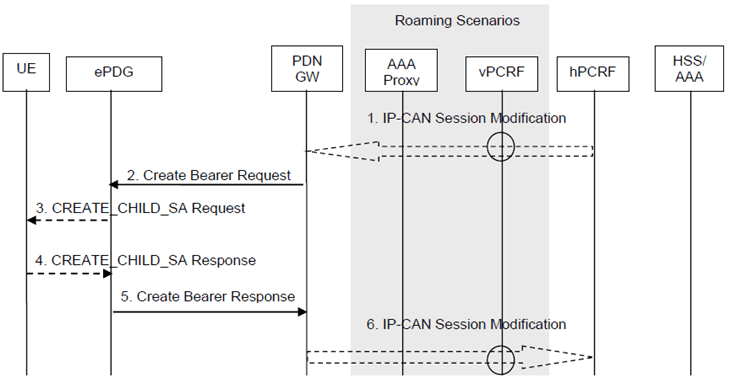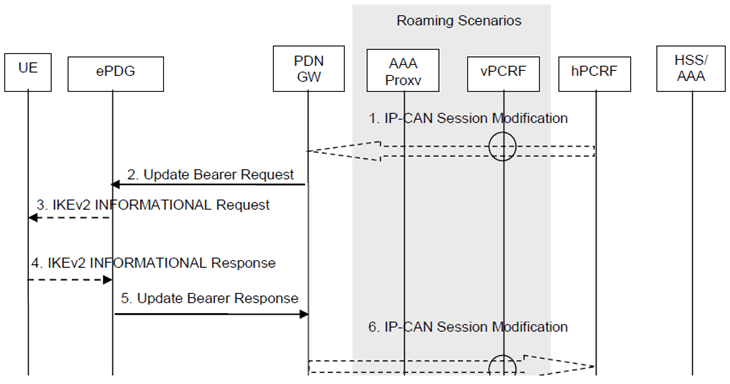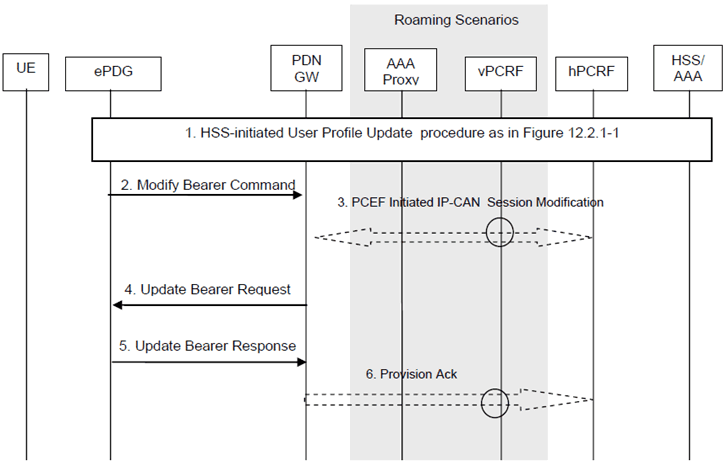Content for TS 23.402 Word version: 18.3.0
0…
4…
4.2…
4.2.2
4.2.3
4.3…
4.4…
4.5…
4.5.7…
4.6…
4.7…
4.7.2…
4.8…
4.8.2a…
4.9…
5…
5.2…
5.4…
5.5
5.6…
5.7…
5.8…
6…
6.2…
6.3
6.4…
6.4.3…
6.5…
6.6…
6.7…
6.8…
6.10…
6.13…
6.15…
7…
7.2…
7.3
7.4…
7.5…
7.6…
7.8…
7.10…
8…
8.2.1.2
8.2.1.3…
8.2.2
8.2.3…
8.2.6…
8.3…
8.4…
8.5…
9…
9.3…
9.4…
10…
13…
16…
16.1.2…
16.1.6…
16.2…
16.2.1a…
16.3…
16.4…
16.7…
16.8…
16.10…
17…
A…
C…
E…
7.10 Dedicated S2b bearer activation with GTP on S2b
7.11 S2b bearer modification with GTP on S2b
7.11.1 PDN-GW initiated bearer modification
7.11.2 HSS Initiated Subscribed QoS Modification
...
...
7.10 Dedicated S2b bearer activation with GTP on S2b |R10| p. 181
The dedicated bearer activation procedure for GTP based S2b is depicted in Figure 7.10-1.

Figure 7.10-1: Dedicated S2b Bearer Activation Procedure with GTP on S2b
(⇒ copy of original 3GPP image)
(⇒ copy of original 3GPP image)
Step 1.
If dynamic PCC is deployed, the PCRF sends a PCC decision provision (QoS policy) message to the PDN-GW. This corresponds to the initial steps of the PCRF-Initiated IP-CAN Session Modification procedure or to the PCRF response in the PCEF initiated IP-CAN Session Modification procedure as defined in TS 23.203, up to the point that the PDN-GW requests IP-CAN Bearer Signalling. If dynamic PCC is not deployed, the PDN-GW may apply local QoS policy. The PCRF may also include a request to provide the User Location Info to the PDN-GW.
Step 2.
The PDN-GW uses this QoS policy to assign the EPS Bearer QoS, i.e., it assigns the values to the bearer level QoS parameters QCI, ARP, GBR and MBR. If this dedicated bearer is created as part of the handover from 3GPP access with GTP-based S5/S8, then the PDN-GW applies the Charging ID already in use for the corresponding dedicated bearer while the UE was in 3GPP access (i.e. bearer with the same QCI and ARP as in 3GPP access). Otherwise, the PGW generates a new Charging Id for the dedicated bearer. The PDN-GW sends a Create Bearer Request message (IMSI, EPS Bearer QoS, TFT, PDN-GW Address for the user plane, PDN-GW TEID of the user plane, Charging Id, LBI) to the ePDG. The Linked EPS Bearer Identity (LBI) is the EPS Bearer Identity of the default bearer.
Steps 3 and 4 only applies if both the UE, and the ePDG support a separate IPsec SA per dedicated S2b bearer
Step 3.
The ePDG shall trigger an IKEv2 CREATE_CHILD_SA message, as defined in RFC 7296. The CREATE_CHILD_SA message shall contain an IKEv2 Notify Payload "TFT" that is a copy of the TFTs received over S2b in step 1. The CREATE_CHILD_SA message shall also contain an IKEv2 Notify Payload "Bearer QoS information".
Step 4.
The UE shall respond with CREATE-CHILD_SA-Response, and shall maintain a binding between the IPsec SA and the applicable TFT and bearer QoS information.
Step 5.
The ePDG selects an EPS Bearer Identity, which has not yet been assigned to the UE. The ePDG then stores the EPS Bearer Identity and links the dedicated bearer to the default bearer indicated by the Linked EPS Bearer Identity (LBI). The ePDG uses the uplink packet filter (UL TFT) and/or IPsec SA where applicable, to determine the mapping of uplink traffic flows to the S2b bearer. The ePDG then acknowledges the S2b bearer activation to the PGW by sending a Create Bearer Response (EPS Bearer Identity, ePDG Address for the user plane, ePDG TEID of the user plane, User Location Information) message.
If the ePDG has established a IPsec SA association with the UE for a dedicated S2b bearer, it shall maintain a binding between the IPsec SA and the EPS bearer ID.
The User Location Information shall include UE local IP address and optionally UDP or TCP source port number (if NAT is detected). It may also include WLAN Location Information (and its Age) the ePDG may have received from the 3GPP AAA server about the UE. When the PDN-GW receives no WLAN Location Information from the ePDG it shall delete any such information it may have stored for the PDN connection.
Step 6.
If the dedicated bearer activation procedure was triggered by a PCC Decision Provision message from the PCRF, the PDN-GW indicates to the PCRF whether the requested PCC decision (QoS policy) could be enforced or not, allowing the completion of the PCRF-Initiated IP-CAN Session Modification procedure or the PCEF initiated IP-CAN Session Modification procedure as defined in TS 23.203, after the completion of IP-CAN bearer signalling. If requested by the PCRF, the PDN-GW forwards to the PCRF following information extracted from User Location Information it may have received from the ePDG:
- WLAN location information in conjunction with the Age of this information,
- The UE local IP address and optionally UDP or TCP source port number (if NAT is detected).
7.11 S2b bearer modification with GTP on S2b |R10| p. 183
7.11.1 PDN-GW initiated bearer modification p. 183
The PDN-GW initiated bearer modification procedure for a GTP based S2b is depicted in Figure 7.11.1-1. This procedure is used to update the TFT for an active default or dedicated S2b bearer, or in cases when one or several of the EPS Bearer QoS parameters QCI, GBR, MBR or ARP are modified (including the QCI or the ARP of the default S2b bearer e.g. due to the HSS Initiated Subscribed QoS Modification procedure, as described in clause 7.11.2).

Step 1.
If dynamic PCC is deployed, the PCRF sends a PCC decision provision (QoS policy) message to the PDN-GW. This corresponds to the initial steps of the PCRF-Initiated IP-CAN Session Modification procedure or to the PCRF response in the PCEF initiated IP-CAN Session Modification procedure as defined in TS 23.203, up to the point that the PDN-GW requests IP-CAN Bearer Signalling. If dynamic PCC is not deployed, the PDN-GW may apply local QoS policy. The PCRF may also include a request to provide the User Location Info to the PDN-GW.
Step 2.
The PDN-GW uses this QoS policy to determine that a service data flow shall be aggregated to or removed from an active S2b bearer or that the authorized QoS of a service data flow has changed. The PDN-GW generates the TFT and updates the EPS Bearer QoS to match the traffic flow aggregate. The PDN-GW then sends the Update Bearer Request (EPS Bearer Identity, EPS Bearer QoS, TFT) message to the ePDG.
Steps 3 and 4 only applies if both the UE, and the ePDG support a separate IPsec SA per dedicated S2b bearer
Step 3.
If either TFTs, and/or bearer QoS information are updated, the ePDG shall trigger an IKEv2 INFORMATIONAL exchange by sending an IKEv2 INFORMATIONAL Request message and shall include the IKEv2 Notify Payload "TFT" and/or "Bearer QoS information" to convey the updated information.
Step 4.
The UE shall respond with an empty IKE v2 INFORMATIONAL Response.
Step 5.
The ePDG uses the uplink packet filter (UL TFT) to determine the mapping of traffic flows to the S2b bearer and acknowledges the S2b bearer modification to the PGW by sending an Update Bearer Response (EPS Bearer Identity, User Location Information) message.
The User Location Information shall include UE local IP address and optionally UDP or TCP source port number (if NAT is detected). It may also include WLAN Location Information (and its Age) the ePDG may have received from the 3GPP AAA server about the UE. When the PDN-GW receives no WLAN Location Information from the ePDG it shall delete any such information it may have stored for the PDN connection.
Step 6.
If the Bearer modification procedure was triggered by a PCC Decision Provision message from the PCRF, the PDN-GW indicates to the PCRF whether the requested PCC decision (QoS policy) could be enforced or not by sending a Provision Ack message allowing the completion of the PCRF-Initiated IP-CAN Session Modification procedure or the PCEF initiated IP-CAN Session Modification procedure as defined in TS 23.203, after the completion of IP-CAN bearer signalling. If requested by the PCRF, the PDN-GW forwards to the PCRF following information extracted from User Location Information it may have received from the ePDG:
- WLAN location information in conjunction with the Age of this information,
- The UE local IP address and optionally UDP or TCP source port number (if NAT is detected).
7.11.2 HSS Initiated Subscribed QoS Modification p. 184
The HSS Initiated Subscribed QoS Modification for a GTP-based S2b is depicted in Figure 7.11.2-1. This procedure does not apply to PDN connections for emergency services.

Step 1.
The HSS updates the User Profile as specified in clause 12.2.1.
Step 2.
If the QCI and/or ARP and/or subscribed APN-AMBR has been modified and there is a related active PDN connection with the modified QoS Profile, the ePDG sends the Modify Bearer Command (EPS Bearer Identity, EPS Bearer QoS, APN AMBR) message to the PGW. The EPS Bearer Identity identifies the default bearer of the affected PDN connection. The EPS Bearer QoS contains the EPS subscribed QoS profile to be updated.
Step 3.
If PCC infrastructure is deployed, the PDN-GW informs the PCRF about the updated EPS Bearer QoS. The PCRF sends new updated PCC decision to the PDN-GW. This corresponds to the PCEF-initiated IP-CAN Session Modification procedure as defined in TS 23.203.
The PCRF may modify the APN-AMBR and the QoS parameters (QCI and ARP) associated with the default bearer in the response to the PDN-GW as defined in TS 23.203.
Step 4.
The PDN-GW modifies the default bearer of each PDN connection corresponding to the APN for which subscribed QoS has been modified. If the subscribed ARP parameter has been changed, the PDN-GW shall also modify all dedicated S2 bearers having the previously subscribed ARP value unless superseded by PCRF decision. The PDN-GW then sends the Update Bearer Request (EPS Bearer Identity, EPS Bearer QoS, TFT, APN AMBR) message to the ePDG.
Step 5.
The ePDG acknowledges the bearer modification to the PDN-GW by sending an Update Bearer Response (EPS Bearer Identity) message. If the bearer modification fails the PDN-GW deletes the concerned S2b Bearer.
Step 6.
The PDN-GW indicates to the PCRF whether the requested PCC decision was enforced or not by sending a Provision Ack message.